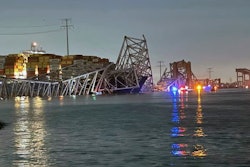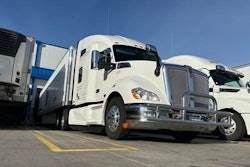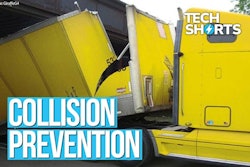Fleet managers typically rely on a number of different technology platforms to keep track of different parts of the business. But what if those could be consolidated?
According to a recent study by trucking tech firm Motive, nearly half of fleet managers use more than 10 individual tools to manage their operations, with nearly a third saying they use too many to count. Fleet maintenance management software company Fleetio is looking to help solve that issue.
Bri Perry, Fleetio’s product marketing manager, joins us this week to talk about the problems with trying to manage so many different platforms and how consolidating them can help fleets be more efficient.
Contents of this video
00:00 10-44 intro
00:29 Fleet management tools
01:08 Consolidating platforms
02:06 Fleet managers and multiple tools
05:39 Syncing data flow
07:05 Integrating telematics
08:52 Pre- and post-trip inspections
10:30 What integrations are available?
Jason Cannon:
CCJ's 10-44 is brought to you by Chevron Delo, heavy-duty diesel engine oil. Now there's even more reasons to choose Delo.
Matt Cole:
How can consolidating fleet management tools help managers improve their operations?
Jason Cannon:
You're watching CCJ's 10-44, a weekly episode that brings you the latest trucking industry news and updates from the editors of CCJ. Don't forget to subscribe and hit the bell for notifications so you'll never miss an installment of 10 44.
Hey everybody, welcome back. I'm Jason Cannon, and my co-host as always on the other side, is Matt Cole. Fleet managers typically rely on a number of different technology platforms to keep track of different parts of the business, but what if a lot of that could be consolidated?
Matt Cole:
According to a recent study by trucking tech firm, Motive, nearly half of managers use more than 10 individual tools to manage their operations with nearly a third saying they use too many to count. Fleet maintenance management software company, Fleetio, is looking to help solve that issue. Bri Perry, Fleetio's product marketing manager joins us this week to talk about the problems with trying to manage so many different platforms, and how consolidating them can help fleets be more efficient.
Bri Perry:
Fleetio is a fleet maintenance management software. We exist to help fleet managers and fleet organizations make better decisions so they can start focusing more on their customers and their mission and driving impact. How do we do that? We help companies with things like automating fleet operations tasks, setting up preventative maintenance scheduling and tracking, and providing insights so fleets can optimize their operations.
We have a web and a mobile app. So the mobile app is useful for drivers and operators out in the field so they can complete vehicle inspections or asset inspections. For fleet managers, they're able to use our system to oversee fleet management and maintenance from start to finish. So things like maintenance schedules, sending out inspection reminders to operators, and streamlining, getting assets in the shop for any kind of org that's using third party maintenance, and we do have a in-house module as well.
Jason Cannon:
While technology does a lot to make all of our jobs easier, having too many options at your disposal can be detrimental. With fleet managers having to manage so many aspects of an operation, it's an even bigger challenge.
Bri Perry:
It is a tough world out there, every time I talk to fleet managers. I have not talked to, I would say two fleet managers who have the exact same setup. You're right, there are so many out there in different portions.
One of the biggest challenges I hear from fleet managers when I'm talking to them about it is you get tools thinking you're going to get a level of transparency and visibility, but the more tools you acquire, sometimes the harder that can become because permissions are different, user seats are different. You start getting into, who needs to see what? How is this happening? Every tool is working slightly different.
So answering one question, I always think, one question. How are maintenance and fuel costs varying by truck? If you're using multiple tools, that can be a really difficult question to answer actually, and knowing that you're trusting the data you're looking at too, if you compile something together.
I work at a tech company, but I wouldn't say I am fantastic at getting into code and working on SQL and trying to run a report. I do know that many fleet managers I talk to are expected to get into the data world now, be data scientists at a lower level. So they can surface those insights and again, improve their operations, but it's difficult when you're using a lot of stuff.
Matt Cole:
Bri says with the nature of trucking, fleets will inevitably have to use multiple platforms, but having platforms that can sync and communicate will solve a lot of inefficiencies. She tells us how, after a word from 10-44 sponsor, Chevron lubricants.
Chevron Delo Ad:
These past few years have been less than easy. We've encountered challenges we never imagined we'd ever have to deal with, from makeshift home offices and video meetings, to global supply chain uncertainty, price instability, market disruptions, and everything in between. Delivering the level of services and products our customers had come to expect was difficult for all of us. We can't change what's behind us, but we can definitely learn from it. We can adapt, evolve, and take steps to reset our thinking, adapt our strategies, and restore your trust in us to better meet your needs now and in the future.
That change begins today. Today we break with convention and introduce a rebalanced line of Delo heavy-duty engine oils. We've reduced our product line from four categories to two, consolidated and simplified. This lineup removes complexity from the manufacturing processes, enhancing price stability and supply chain reliability so you can trust you will have the premium products you need to keep your business always moving forward. Our break with convention optimizes the Delo lineup to allow you to provide your customers with the best synthetic blend and synthetic heavy-duty engine oils in the market, fully available at prices you can rely on. It's your assurance that you'll be well positioned to be their trusted source for proven engine protection that keeps equipment on the job, giving your customers even more reasons to choose Delo.
Bri Perry:
I will preface by saying that I think the fleet space from when I talk to people, when I talk to integration partners, it's still very much a developing field, but the more you can get to sync or automate that data flow from one tool to another, because more than likely a lot of the trucking customers that I talked to, you're going to have multiple solutions. A lot of them are using telematics, a lot of them are tracking fuel, and then obviously you've got that maintenance component. The big three, the top three. Centralizing as much of it as possible is at least going to help get rid of some of the bigger spots that could be missed and allow people to think maybe a little bit more about how they could be approaching certain business decisions, or even surface things that fleet managers or owners maybe hadn't thought of. It's a little bit more down the road, we're looking to scale in a couple of years. What do we need to be thinking about? What information do we need to be surfacing. By centralizing and having a platform bring in as much data as possible and then surface stuff to you, you're able to get ahead of stuff and that's the biggest thing. Preventative maintenance, but also just preventative operations, like thinking about scaling in the future and what you could be doing as a fleet manager or as an organization.
Jason Cannon:
Bri says integrating the telematics of a fleet with a platform like Fleetio can help fleets be more proactive on maintenance than reactive, and that's helping a business's bottom line.
Bri Perry:
One of the biggest benefits from the integration side that we do see is that centralization, because without it, preventative maintenance, good preventative maintenance, scheduling, we're using odometer values, for instance, to try and check based on daily usage when we may want to generate a reminder or surface that. Well, when you've got thousands of assets and you think about how many times you need to update those odometers, the best thing is to get that again, flowing into Fleetio if you're using a telematics solution or any solution, to be able to streamline that just a little bit, cut out the manual work.
But also from the maintenance side when it comes to thinking more again of our telematics integrations, anything that can help bring in automatically fault codes, DTCs, something that you're getting from the vehicle that can again flow right in and create more of an automated workflow where it isn't so much of a handoff process if something is tagged as maybe wrong or needs to be looked at. It doesn't have to go through all different hands or a phone call and an email and now you're texting someone and you're trying to coordinate. It can happen in one platform. It automatically comes in, you get the notification. It's just reducing all of the stuff where you're having to keep it all in your head for some customers and believing that a little bit. Setting up, when something happens, we'll get it right into the platform. We can start the maintenance, or we can look at it and say, maybe this doesn't need the work right now, and that can also be a really good time saver for a fleet as well. So those are a couple examples.
Matt Cole:
Fleets utilizing Fleetio can also set their drivers up on the mobile app, allowing them to go through their pre and post-trip inspections and automatically trigger a maintenance work order if something in those inspections fails.
Bri Perry:
That's the biggest thing that we see drivers and operators using the app for is digitizing inspections. Again, having a place where if you're doing it in one platform or solution, when an inspection item fails, having that right then and there trigger a maintenance workflow and get that stuff going, can be so beneficial and helpful. Then once it is, they're using the same app to acknowledge that the issue has been fixed once it comes around to that next inspection, and then the whole thing has just been handled from start to finish.
I think there's also a really large collaboration component to the mobile app too. So being able to comment, do a quick comment in an inspection form submission, or just on the vehicle itself if you need to for some fleets, if they are switching from one asset to another, being able to just comment that out. Then you have a nice audit trail between drivers or operators. I've also seen instances where operators like a technician, has a question of what was going on while an asset was being driven, and you can do that again right in the app too. So it's helping bridge what could be a lot of barriers in a fleet where you don't have someone's number, you're trying to figure out where they are, maybe you're not even remotely in the same place, you're not in the same location. You can bring the phones out and streamline that.
Jason Cannon:
Bri says the first step in consolidating the different platforms you're using is to look at what integrations are available and to figure out which platforms can work with others.
Bri Perry:
I would say to start looking at what integrations are available. A lot of solutions out there are building strong marketplaces. We have a really robust app directory where we've got third party people who've built integrations with us. We have an open API. Just having conversations, I think, with the solutions that you're either evaluating or already using to say, what component am I missing from this? What do you integrate with that could help solve that problem? It's a really good place to start.
Then I love to suggest going a step further because I've heard it directly from fleet managers. Their biggest thing when they've gone through that process telling me is also thinking about, again, scaling. So even if it fits the bare minimum now, what else could a potential solution that you're looking at bringing in or connecting, offer you down the road? If you have more time that you're given back or you're seeing the ROI immediately from, let's say again, trying to reduce maintenance costs. How much further can you take it and what tools do you have in your tool belt right now that can get you there? Then again, if you're in the evaluation stage or just seeing what's out there and looking, having a conversation and asking, sometimes you don't know what you don't know, so having someone going through and say, well, this is how far we can take you is an excellent place to be to start.
Jason Cannon:
That's it for this week's 10-44. You can read more on ccjdigital.com. While you're there, sign up for our newsletter and stay up to date on the latest in trucking industry news and trends. If you have any questions or feedback, please let us know in the comments below. Don't forget to subscribe and hit the bell for notifications so you can catch us again next week.










